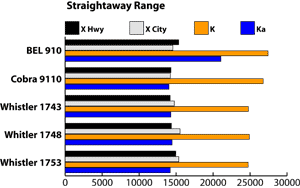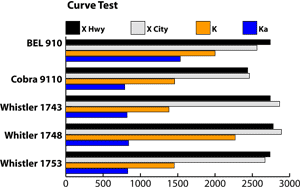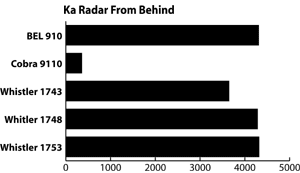The $99 Detector Test
BEL vs. Cobra vs. Whistler
by Craig Peterson
9/5/2003
Over a dozen years ago we achieved instant notoriety by virtue of conducting the first of many detector tests for Automobile magazine. The test itself wasn't an issue but our selection of models certainly created a furor among the manufacturers. That's because rather than concentrating solely on high-end units we chose instead to evaluate models with retail prices at $99 and below.
This was a calculated move since this segment constitutes the bulk of the detector market, but we knew full well that the industry had almost universally skimped on performance at that price level, especially on then-new Ka band. For that matter, Ka sensitivity wasn't all that wonderful even on high-end models of the day. And our test results confirmed the worst: only one $99 model offered adequate protection against the latest radar threat.
Ten-odd years later, given this additional time to finally get a handle on Ka-band performance, along with lasers, which have arrived during the interim, we naturally were curious if at last it's possible to buy real protection for less than a C-note. To find out we gathered up every available model with a average street prices within a few bucks of $99 and ran them through our full battery tests. (Some new models were about to be introduced but were unavailable. If you don't see it listed here you may find it in a more recent review.) With the candidates listed alphabetically, here's what we found.
BEL Express 910
 The
least expensive of the three-model Express lineup, the 910 replaces
the Express 906 and is built on a completely new platform. The Express
910 shares its case with two more-expensive Express models--the
920 and 930--that differ primarily in features. [Note: The 910 was replaced by the Express 925 and Express 935 models. A model offered only through Radio Shack, the BEL 795, also used the same platform and had similar performance.]
The
least expensive of the three-model Express lineup, the 910 replaces
the Express 906 and is built on a completely new platform. The Express
910 shares its case with two more-expensive Express models--the
920 and 930--that differ primarily in features. [Note: The 910 was replaced by the Express 925 and Express 935 models. A model offered only through Radio Shack, the BEL 795, also used the same platform and had similar performance.]
Four buttons control all functions. On the top of the case, from the far left are the power/volume, dim/dark, auto/manual mute and city/highway switches. Volume is adjusted by pressing and holding the power/volume button, our least favorite method of handling this task due to the necessity of holding the button down until the desired level is reached. Fortunately, once adjusted the unit retains this setting in memory, along with other user preferences.
Signal strength is indicated audibly by beep frequency, visually by a large numeral, 1 through 9. Relative sound level is also depicted by the display of numbers 1 through 9. By the time 9 appears you'll be looking for earplugs; at an average of 93 decibels it's one of the loudest units we've tested, making it a good choice for noisy cockpits.
Band ID is denoted by differently colored icons. A pair of LEDs on the left side of the face denotes power-on and city/highway status.
This BEL is a no-frills, just-the-basics model and trades heavily on its performance which, we determined, is considerable. At the straightaway test site it spotted X-band in highway mode from 2.9 miles away, marginally edging out the Whistler 1753 by a few hundred feet and the Cobra 9110 by about 1,100 feet. In X/City mode the order was reversed: the Whistler 1753 weighed in with 15,363 feet versus the BEL 910's 14,566 feet and the Cobra 9110's 14,241.
Of more interest, due to the fact that X-band radar has largely disappeared in the U.S., the BEL sniffed out K-band radar from 5.2 miles away and Ka band from 3.99 miles, the best of any unit tested. Against Ka-band radar coming from behind, the BEL scored within a few feet of the winning Whistler 1753, some 4,000 feet better than the Cobra.
The BEL's biggest triumph arrived in the curve test. With radar aimed at the middle of a sharp downhill curve and targeting vehicles at barely 700 feet, all the contestants were capable of detecting the X- and K-band guns at 1,400 to 2,700 feet. But on the stealthy Ka band, that margin shrank dramatically. The Whistlers averaged 826 feet and the Cobra 791 feet, not enough warning to out-brake the radar. But the BEL delivered 1,535 feet of range, plenty of warning for all but the truly brain-dead to adjust their speed.
In town, the BEL Express 910 proved to be the quietest low-end BEL model we've tested, a tribute to major strides the company has made in signal-processing software over the past few years.
Cobra ESD-9110
 Nearly
identical in appearance to its sibling, the 9210 ($119), the front
of the 9110's stylish titanium-and-black-colored case is dominated
by one of the industry's largest and brightest alphanumeric
displays. It's one of the few we've seen that remains
totally visible both off-angle and in direct sunlight.
Nearly
identical in appearance to its sibling, the 9210 ($119), the front
of the 9110's stylish titanium-and-black-colored case is dominated
by one of the industry's largest and brightest alphanumeric
displays. It's one of the few we've seen that remains
totally visible both off-angle and in direct sunlight.
Except for power/volume, four buttons on top of the case control all functions. Farthest to the left is the Smart Mute button and to its right, the mute button for manual and auto muting. It's flanked on the right by the buttons for display dim/dark and city/highway A dual-purpose power/volume thumbwheel switch is on the left side of the case near the front.
Signal strength is indicated audibly by beep frequency, visually by numeric display (1 through 5, on the far right of the display).
The three radar frequencies are denoted by X, K and Ka icons and there's also an S. That indicates Strobe Alert, the ability to detect signals from the optical transmitters used by emergency vehicles in some cities to control traffic signals. It also can mean Safety Alert, Cobra's safety radar system that hasn't been seen in years.
Like all detector manufacturers, Cobra's been searching for ways to limit urban false alarms. Their solution is Smart Mute, which automatically mutes alerts based on vehicle speed.
The Cobra turned in generally creditable test scores but showed a few holes in its performance envelope. At both the straightaway and curve test sites it marginally trailed the Whistlers on X- and Ka band, slightly edging them out on K band. But it had far less laser field of view than the class-leading Whistlers and was nearly blind to radar coming from behind. In all, we'd say the BEL and particularly the Whistlers offer more for less.
Whistler 1743/1753
 Whistler
this year introduced a significant number of new models, several
of them hovering around the magic C-note price point. Most are built
on two basic platforms with the 1733/43/53 models sharing a slightly
smaller housing than the 1748/83/93 models.
Whistler
this year introduced a significant number of new models, several
of them hovering around the magic C-note price point. Most are built
on two basic platforms with the 1733/43/53 models sharing a slightly
smaller housing than the 1748/83/93 models.
Although we tested only the 1743 and 1753, the 1733 ($79.95 suggested retail) shares this platform and differs principally in features, so we expect its performance to be comparable. The Whistler 1734 is identical save for features. You can read my reviews of these plus the newer Whistler SRT-30 and SRT-35 models in a more recent test, Best New Detector Under $99. Another new model was also reviewed, the DE 1788, a cordless design.
Like the other member of this series the 1743 and 1753 have attractive titanium-and-black upper cases. They sport five buttons: from the far left is the power switch (it also controls the two-step dim/dark feature) flanked by buttons for city/highway, audio quiet (the mute switch that also controls Option Select mode) and volume. The last is handled by a pair of switches--one for volume-up, the other -down--an improvement over detectors sporting a single momentary-on volume button that is both slower and less intuitive to use.
The 1743 uses icons of different colors to display information about operating mode and band ID. Highway is pale green and City light orange; both colors tend to disappear in sunlight. Icons for signal strength and other operating modes are red, making them far easier to read. The 1753 has a high-resolution red text display for mode and band ID that's more readable.
In the straightaway test the pair weighed in with the best X-band city-mode performance of the bunch. Both also delivered excellent K- and Ka-band detection. At the curve test site the gap narrowed, with the Cobra and Whistlers nearly dead even.
Whistler 1748
 Somewhat
larger than its diminutive relatives, the 1743 and 1753, the 1748
shares its case with the 1783 and 1793 models which offer different
features but nearly identical performance.
Somewhat
larger than its diminutive relatives, the 1743 and 1753, the 1748
shares its case with the 1783 and 1793 models which offer different
features but nearly identical performance.
The 1748 benefits from the same handsome styling as the other new Whistler models: titanium-and-black upper case, black lower body. Atop the case, five buttons control all functions. On the far left is the power switch, also used to regulate the two-step dim/dark feature; to its right are the buttons for city/highway, audio quiet and volume.
The 1748 uses icons of different colors for status and mode indicators and for band ID and signal strength. Most are dark enough to be readable in most lighting conditions although four cardinal points of the integral compass are light green and hard to read in bright sunlight.
Audible band ID arrives via very distinct tones and by Real Voice (human versus synthesized) alerts that, as in the 1743/1753 models, are the best we've heard.
At the straightaway test site the 1748 had the most range of the bunch in X-band city mode and ranked second to the BEL 910 on K and Ka band. At the more difficult curve test site it walked away with top honors in X-band city, X-band highway and K band performance while edging out all but the BEL on Ka band. Its laser performance duplicated that of the other Whistlers which all had substantially better field of view than the competition. In all, a very consistent showing.
Test Results












